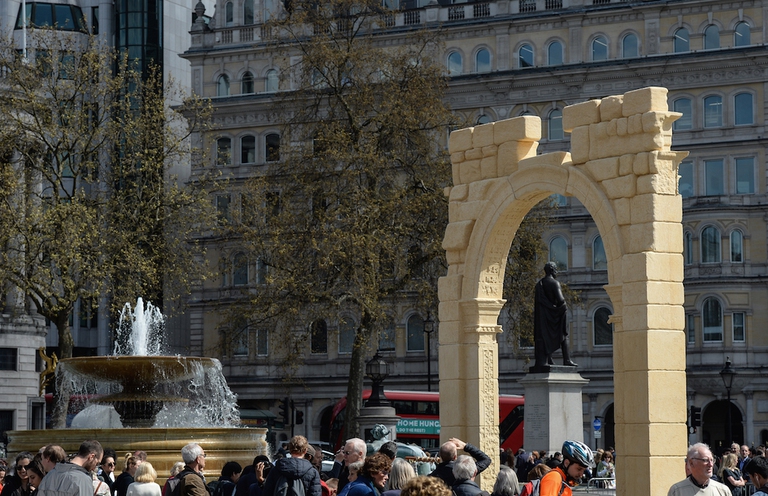
Homecast is a podcast series recorded in quarantine in which creatives from around the world share their lived experiences of these unique circumstances. Creator Giacomo De Poli tells us why this collective diary was needed now more than ever.
Il 19 aprile inaugura l’installazione che vede la ricostruzione in 3D dell’arco di trionfo di Palmira a Trafalgar Square, Londra. Con una tecnologia che è anche un po’ italiana
What ISIS has torn down, technology recreates. If not exactly the same as before, at least as a memory of what it once was. Because, in the end, this is another way of fighting terror, fear and ignorance: by trying to preserve the memories of populations that have been torn apart, such as the Syrian one, in any way possible. That is what is taking place in London’s Trafalgar Square starting from the 19th of April. The Triumphal Arch of Palmyra, completely destroyed in October 2015 during ISIS’ occupation of the ancient site, retaken by Syrian government forces in March this year, has been rebuilt in the middle of the historic square to two-thirds of its original size thanks to 3D technology. The installation coincides with World Heritage Week.
The initiative involves a number of actors: first of all, Oxford’s Institute of Digital Archaeology, which collected an impressive amount of data thanks to the Million Image Database, an open-access archive of 3D images of at-risk or demolished sites. Since the beginning of 2016, the institute has given around 5,000 cameras to archaeologists working in the Middle East and North Africa, as well as tourists and citizens, with the objective of creating three-dimensional photographs of at-risk monuments and sites in order to use them for educational purposes and eventually recover them. The reconstruction is thus based on a 3D rendering made possible by this database and other resources. UNESCO, the University of Oxford, Dubai’s Museum of the Future and the government of the United Arab Emirates were also involved in the collection of data.
The Triumphal Arch of Palmyra was rebuilt almost to scale; two Italian companies worked with the Institute of Digital Archaeology in supplying the materials, 3D technology, and the labour of sculptors and a robot. Five and a half metres tall, it was carved out of Egyptian marble using the largest 3D printer in the world; it weighs 11 tonnes and cost over 140,000 dollars to make.
[vimeo url=”https://vimeo.com/161046225″]
The value of this initiative, naturally, isn’t confined to Palmyra. Whilst the city has become a symbol of the destruction of archaeological historical memory, we mustn’t forget the thousands of so-called “minor” sites that risk destruction due to conflict. “By using digital techniques to map and preserve monuments and other aspects of shared human history, we are able to ensure that nobody can deny history or […] our shared aspiration to live together in harmony,” said Mohammed Abdullah Al Gergawi, Dubai’s Minister of Cabinet Affairs and The Future.
After the time spent in Trafalgar Square, three days, the installation will be moved to New York. The ultimate objective is to bring the structure back home to Palmyra with the permission of the Syrian people.
Siamo anche su WhatsApp. Segui il canale ufficiale LifeGate per restare aggiornata, aggiornato sulle ultime notizie e sulle nostre attività.
![]()
Quest'opera è distribuita con Licenza Creative Commons Attribuzione - Non commerciale - Non opere derivate 4.0 Internazionale.
Homecast is a podcast series recorded in quarantine in which creatives from around the world share their lived experiences of these unique circumstances. Creator Giacomo De Poli tells us why this collective diary was needed now more than ever.
La guerra in Siria dura ormai da sei anni: ecco le dieci date spartiacque di un conflitto che ha provocato 321mila morti e quasi cinque milioni di profughi.
Syrian regime forces have regained control of the city of Palmyra, ten months after its capture by the so-called Islamic State (ISIS). The Islamist militants were driven out of the ancient site on the 27th of March following three weeks of intensive military operations backed by Russian air strikes and Lebanese militias. During its
Time magazine’s 100 Women of the Year project sheds light on influential women’s stories, from Amelia Earhart to Greta Thunberg. A selection of some of the greats for International Women’s Day.
Leaving cliches behind, beauty and sexuality in old age are widely unexplored topics. Photographer Arianne Clément tells why she chose to shed light on this universe.
Un violador en tu camino – the rapist is you – is an anthem protesting the impunity of gender-based violence. It began in Chile and has become a global flash mob, bringing people to the streets and resonating all over the world.
The Oxford English Dictionary has chosen “climate emergency” as 2019’s Word of the Year because of its effectiveness in communicating a sense of urgency in the fight against global warming.
Filmmaker Dhondup Wangchen was imprisoned by the Chinese government for his documentary condemning the Tibetan condition. He tells us how he continues to fight for his people even after the traumas faced.
To mark the release of Anthropocene: The Human Epoch, we interviewed photographer and co-director Edward Burtynsky, who told us the story behind the documentary.








